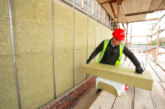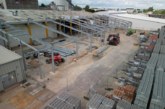SIG’s Richard Parker examines the benefits specifying the right insulation can bring to your development.
When considering solutions for reducing heat loss, the issue of sustainability has become a key one for housebuilders and homeowners, just as important as maintaining a comfortable environment and controlling energy bills.
With as much as 85% of all home heat loss from a property occurring through the roof or walls, the benefits of thermal insulation are clear. An important tool for reducing heat loss, it can also help homeowners make significant savings on utility costs – with estimates suggesting good quality insulation could shave as much as £250 per year from energy bills.
Considering that the average loft costs around £300 to insulate, homeowners could see return on their insulation investment in as little as two years. However, the savings don’t stop there. High levels of insulation and air-tightness have long been associated with the carbon-efficient Passivhaus concept, a property built to stringent energy-efficient design standards to ensure it maintains an almost constant temperature, strengthening its sustainability credentials.
Indeed, as is the case for the wider construction industry, sustainability is an ever-growing watchword for house-builders. Ambitious government carbon reduction targets and increasingly environmentally conscious buyers have necessitated the rise of the so-called ‘eco-home’ – something insulation plays a vital role in.
By reducing heat loss in winter and helping keep properties cool in the warmer months, insulation reduces reliance on energy-intensive central heating and air conditioning units. In the long-term, this can see the carbon footprint of individual houses shrink significantly.
So, with such obvious benefits, what are some of the key things to consider when investing in insulation? Taking roofing insulation as an example, the type of material used is perhaps the single biggest consideration and understanding the key differences – and associated benefits – can help housebuilders make an informed choice when specifying insulation for a property. Typically, the choice spans:
• Polyurethane / Polyisocyanurate – highly cost-effective, with high levels of compressive strength – helping it resist damage or deformation when under particular strain. This is particularly useful if the roofing is designed for pedestrian access, for example, as a terrace or green roof, which are increasingly popular in a domestic setting
• Polystyrene – Polystyrene insulation is a low thermal conductor, meaning it keeps properties warm in winter and cool in summer. Polystyrene is typically used in inverted roofs
• Stone wool – Often termed ‘mineral fibre’ or ‘rock wool’, this material is made from melted natural rock that is spun into long strands of fibre, which is then gathered and condensed into a high-density mat. Non-combustible, it offers effective fire resilience, thermal efficiency and acoustic solutions, making it a preferred insulation choice for larger-scale developments, such as gyms or shopping centres
• Cellular glass – A newer addition to the insulation mix, cellular glass is typically used in high-end specification projects and sees crushed glass heated to high temperatures and mixed with a cellulating agent when melted
With an extensive product range that spans acoustic to wall, floor to roof, we at SIG are committed to providing all the insulation technology and expertise housebuilders need for their next job – be it new build or renovation.









